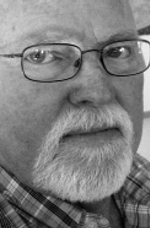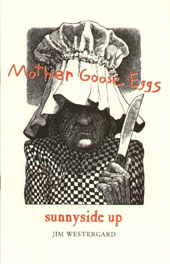The Porcupine's Quill
Celebrating forty years on the Main Street
of Erin Village, Wellington County
BOOKS IN PRINT
Mother Goose Eggs by Jim Westergard
Those who love Edward Gorey’s Gashlycrumb Tinies or Hilaire Belloc’s Cautionary Tales for Children will adore Jim Westergard’s darkly comic portraits. He illustrates each nursery rhyme twice. First, we meet the young and not-so-innocent heroes of the poems. Then we see them in their retirement, in a rogue’s gallery of unrepentant outcasts, crones and sociopaths.
Looking for a place to lay blame for all the violence and cruelty in the world today? Lay it at the feet of Mother Goose. A close look at Mother Goose’s nursery rhymes reveals cruelty, violence and bizarre behaviour. Now consider that some, or even most, of the characters in the Mother Goose nursery rhymes were modelled on real people and you’ve got the beginnings of Mother Goose Eggs, sunnyside up.
Mother Goose laid some juicy goose eggs, sunnyside up, around the nursery. The rhymes we knew as children were also read aloud to our great, great, great grandparents and, in their day, the stories were intended to prepare them for survival in a world much tougher than our own.
Jim Westergard has selected some of the more violent, cruel and unusual nursery rhymes from Mother Goose and has imagined the characters as real people. As he offers the rhymes, often with additional verses never heard before, the artist presents his portrait of the younger participant in the rhyme. Then we’re confronted, on the opposing page, with the same character depicted much later in a life that has typically not been kind, together with Jim’s commentary on their plight.

2006—Unisource Litho Award,
Winner
Review quote
‘Jim Westergard may not be the first to invest children’s standards with modern sensibilities (think Jon Scieszka’s The True Story of the 3 Little Pigs or James Finn Garner’s Politically Correct Bedtime Stories), but he achieves a special blend of sarcasm and poignancy in Mother Goose Eggs, Sunnyside Up. The book pairs 25 Mother Goose nursery rhymes (many of which include an unfamiliar and disturbing stanza or two) with Westergard’s engravings. With tongue in cheek, Westergard plays up the cruel nature of many classic nursery rhymes -- spousal abuse in ‘‘Tom, Tom, of Islington’’, child neglect in ‘‘Hush a by Baby’’, and religious oppression in ‘‘Goosey, Goosey, Gander’’, for example. He illustrates each rhyme with a two-colour portrait and a larger, black-and-white depiction of the young protagonist as they might have aged -- which is usually not very well.’
—Quill and Quire
Review quote
‘Mother Goose Eggs is thoughtful and expertly researched. A reader may pause to consider what life was like when the original poems were written. They may have been historical accounts of the tribulations that different societies and cultures endured in the past. Westergard has put doubt into our minds as to the innocence of children’s stories and parents everywhere should be on guard!’
—Andrea Mackay, Scene Magazine
Review quote
‘As Bruno Bettelheim explained in The Uses of Enchantment, nursery rhymes and fairy tales confront children head-on with basic human predicaments and existential dilemmas. They exaggerate and distort but they do not try to hide the filthy underbelly of the world -- people’s backs are broken, mice are mutilated. Westergard has great, socially incisive fun by taking the rhymes at their straight-faced literal level, thereby backhandedly pointing to our hyper-protective culture of parenting. He underscores the daftness of making strictly deterministic connections between what is read in childhood and one’s life as an adult.’
—Christopher Wiebe, vue weekly
Review quote
‘Great attention has been taken with the production of the book. It is printed on wonderful cream paper stock, with a special type font and decorated initial letters, as well as carefully laid-out pages. The original wood engravings are well-executed portraits. However, while some adults may appreciate the bizarre dark humour, this is not a book to share with children.’
—Alison Mews, Canadian Book Review Annual
Review quote
‘There is a laugh on every page.’
—Marc Horton, Edmonton Journal
Promotional headline
‘The Westergard book is such a goofy delight!’
—William Rueter
Author comments
‘Years ago I had gotten my hands on a small collection of type and I chose twelve point Scotch Roman for the text of the book. One day I decided to give type setting a try and I started picking out each letter; searching through the little compartments of the type drawer, and placing them into words and lines in a galley (which looks like a cookie tray with three sides). When I had completed the first poem I pinched all the letters and spacers together with the fingers of both hands, picked them up from the galley and carried them carefully to the press to set them in place. Halfway to the press some individual letters started to drop from the middle of the bunch, then the rest flew in all directions. I was on my hands and knees picking them out of the ‘‘dust bunnies’’ who live under the press and furniture and as I was down there I asked myself whether I really wanted to go through with this tedious process. I couldn’t imagine printers staying in the profession very long if this was what their days were like, and I figured there had to be some professional secrets I was missing.’
Back cover copy
‘Many wood engraving books are collections of previously executed work; relatively few are new creations. This must be one of an even smaller handful that is truly engraving-led and breaks new ground. It is a triumph. Jim Westergard sees making a book as quite a different thing from making a print (or two, or, in this case, fifty).’
—Simon Brett, Parenthesis
Introduction or preface
Looking for a place to lay the blame for the cruelty, violence and abuse in the world? Why not blame it all on Mother Goose? Violence, cruelty and abuse are scattered throughout those nursery rhymes of hers.
I have an early memory of a frightening nursery rhyme, about a neglected baby, left up in a tree, who would come crashing to the ground when the branch broke. Then there was the one about going to sleep and maybe never waking up.
The little darlings can’t distinguish fact from fiction at that age; those were real people there, having terrible things happening to them! No wonder some of those little nursery residents grew up disturbed, deviant or traumatized.
Later, when the parents were reading the nursery rhymes to their own children, they realized that their parents had done some editing, and they began to edit too. They also noticed some had never been read at all.
Mother Goose dates back to the days when childhood did not generate fond memories. The rhymes were often meant to teach the kiddies how to participate in a cruel world. A few of these nursery rhymes have violent, brutal and bizarre content. There are also, among these, a couple that contain some good advice.
Let’s pretend the characters in these nursery rhymes were real people (in some cases they were) and that they’re now retired. How would their years alter their faces?
This book is not a serious study of children’s literature and makes no claim to historical or literary accuracy.
The two books used as references for these nursery rhymes were The Real Mother Goose, published by Checkerboard Press, 1991, and The Annotated Mother Goose by William and Ceil Baring-Gould, published by Bramhall House, 1962.
Mother Goose, the source of delightful childhood rhymes and lessons, laid a few eggs around the nursery, sunny side up. Bon appétit!
Jim Westergard was born in Ogden, Utah in 1939. He was educated at a variety of colleges and universities in California, Arizona and Utah where he completed his BFA and MFA at Utah State. Westergard taught at Metropolitan State College and Northern Illinois University before moving to Alberta in 1975, where he taught at Red Deer College until his retirement in 1999. He became a Canadian citizen in 1980.
Jim Westergard has been creating prints from wood engravings since university days in the late 60s, but had never completed a book-length collection until the original limited letterpress edition of Mother Goose Eggs. The first engraving for this project was finished in 1999. Then, after a four-year struggle which included an unexpected hernia operation and reprinting the press-sheets a second time with helpful hints from Crispin Elsted of the Barbarian Press (Mission, BC), Mother Goose Eggs was finally bound and released in a deluxe edition of eighty copies in 2003.
Westergard continues to create wood engravings on his cantankerous old VanderCook SP-15 proof press which he has affectionately named the ’Spanish Fly’. His recent titles include Oddballs (Porcupine’s Quill, 2015) and See What I’m Saying? (Porcupine’s Quill, 2018).
For more information please visit the Author’s website »
The Porcupine's Quill would like to acknowledge the support of the Ontario Arts Council and the Canada Council for the Arts for our publishing program. The financial support of the Government of Canada through the Canada Book Fund (CBF) is also gratefully acknowledged.





